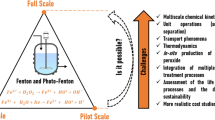Abstract
Electrocoagulation (EC) was applied for elimination of dissolved Fe3+ ions from model contaminated water. Electrochemical experiments were performed using a coagulation set-up with the volume of storage tank of 50 L. To represent inorganic contamination, FeCl3·6H2O was chosen as a model pollutant; its concentration was equal to 50 mg/L. Experiments were carried out by circulating model effluent (1 pass) through the cell at a flow rate (40 L/h) whilst operating the power supply in galvanostatic mode. Dosing concentration was varying by changing the input current between set points and holding for sufficient time for steady state to be reached and for a sample to be collected. The process using the steel electrode reached removal efficiency up to 99%, depending on pH, and proved to be very suitable for elimination of dissolved Fe3+ ions from water. However, electrochemical experiments using the aluminum electrode reached removal efficiency only up to 25%. The different efficiency of two anodes is probably due to lower adsorption capacity of hydrous aluminum oxide for iron ions in comparison to hydrous ferric oxides. Produced nanostructured flocs were subsequently filtered, dried, and characterized by N2 physisorption, X-ray photoelectron spectroscopy, and scanning electron microscopy. Obtained characteristics synchronously demonstrate different tendencies of Al and Fe nanostructured flocs.










Similar content being viewed by others
References
Khatri N, Tyagi S, Rawtani D (2017) Recent strategies for the removal of iron from water: a review. J Water Process Eng 19:291–304. https://doi.org/10.1016/j.jwpe.2017.08.015
Tekerlekopoulou AG, Vasiliadou IA, Vayenas DV (2006) Physico-chemical and biological iron removal from potable water. Biochem Eng J 31(1):74–83. https://doi.org/10.1016/j.bej.2006.05.020
Du X, Liu G, Qu F, Li K, Shao S, Li G, Liang H (2017) Removal of iron, manganese and ammonia from groundwater using a PAC-MBR system: the anti-pollution ability, microbial population and membrane fouling. Desalination 403(Supplement C):97–106. https://doi.org/10.1016/j.desal.2016.03.002
Alimohammadi V, Sedighi M, Jabbari E (2017) Experimental study on efficient removal of total iron from wastewater using magnetic-modified multi-walled carbon nanotubes. Ecol Eng 102(Supplement C):90–97. https://doi.org/10.1016/j.ecoleng.2017.01.044
Ellis D, Bouchard C, Lantagne G (2000) Removal of iron and manganese from groundwater by oxidation and microfiltration. Desalination 130(3):255–264. https://doi.org/10.1016/S0011-9164(00)00090-4
Vaaramaa K, Lehto J (2003) Removal of metals and anions from drinking water by ion exchange. Desalination 155(2):157–170. https://doi.org/10.1016/S0011-9164(03)00293-5
Andersen WC, Bruno TJ (2003) Application of a gas–liquid entraining rotor to supercritical fluid extraction: Removal of iron(III) from water. Anal Chim Acta 485(1):1–8. https://doi.org/10.1016/S0003-2670(03)00400-8
Talaiekhozani A, Talaei MR, Rezania S (2017) An overview on production and application of ferrate (VI) for chemical oxidation, coagulation and disinfection of water and wastewater. J Environ Chem Eng 5(2):1828–1842. https://doi.org/10.1016/j.jece.2017.03.025
Mollah MYA, Schennach R, Parga JR, Cocke DL (2001) Electrocoagulation (EC)—science and applications. J Hazard Mater 84(1):29–41. https://doi.org/10.1016/S0304-3894(01)00176-5
Hakizimana JN, Gourich B, Chafi M, Stiriba Y, Vial C, Drogui P, Naja J (2017) Electrocoagulation process in water treatment: a review of electrocoagulation modeling approaches. Desalination 404(Supplement C):1–21. https://doi.org/10.1016/j.desal.2016.10.011
Tito DN, Krystynik P, Kluson P (2016) Notes on process and data analysis in electro-coagulation—the importance of standardisation and clarity. Chem Eng Process 104(Supplement C):22–28. https://doi.org/10.1016/j.cep.2016.02.011
Schwertmann U (1991) Solubility and dissolution of iron oxides. In: Chen Y, Hadar Y (eds) Iron nutrition and interactions in plants: “Proceedings of the fifth international symposium on iron nutrition and interactions in plants”, 11–17 June 1989, Jerusalem, Israel, 1989. Springer Netherlands, Dordrecht, pp 3–27. https://doi.org/10.1007/978-94-011-3294-7_1
Moussa DT, El-Naas MH, Nasser M, Al-Marri MJ (2017) A comprehensive review of electrocoagulation for water treatment: Potentials and challenges. J Environ Manage 186(Part 1):24–41. https://doi.org/10.1016/j.jenvman.2016.10.032
Hashim KS, Shaw A, Al Khaddar R, Pedrola MO, Phipps D (2017) Iron removal, energy consumption and operating cost of electrocoagulation of drinking water using a new flow column reactor. J Environ Manage 189(Supplement C):98–108. https://doi.org/10.1016/j.jenvman.2016.12.035
Krystynik P, Kluson P, Tito DN (2015) Water treatment process intensification by combination of electrochemical and photochemical methods. Chem Eng Process 94(Supplement C):85–92. https://doi.org/10.1016/j.cep.2015.01.004
Lecloux A, Pirard JP (1979) Importance of standard isotherms in the analysis of adsorption-isotherms for determining the porous texture of solids. J Colloid Interface Sci 70(2):265–281. https://doi.org/10.1016/0021-9797(79)90031-6
Shirley DA (1972) High-resolution X-ray photoemission spectrum of the valence bands of gold. Phys Rev B 5(12):4709
Aber S, Amani-Ghadim AR, Mirzajani V (2009) Removal of Cr(VI) from polluted solutions by electrocoagulation: Modeling of experimental results using artificial neural network. J Hazard Mater 171(1):484–490. https://doi.org/10.1016/j.jhazmat.2009.06.025
Ghosh D, Solanki H, Purkait MK (2008) Removal of Fe(II) from tap water by electrocoagulation technique. J Hazard Mater 155(1):135–143. https://doi.org/10.1016/j.jhazmat.2007.11.042
Krystynik P, Tito DN (2017) Key process parameters affecting performance of electro-coagulation. Chem Eng Process 117(Supplement C):106–112. https://doi.org/10.1016/j.cep.2017.03.022
Acknowledgements
The financial support of Technology Agency of the Czech Republic (project No.: TA04020130) is gratefully acknowledged. Part of the work was financed by Research Infrastructure NanoEnviCZ (project No.: LM2015073).
Author information
Authors and Affiliations
Corresponding author
Ethics declarations
Conflict of interest
The authors declare that they have no conflict of interest.
Additional information
Highlights
-
Electrochemical production of nanostructured flocs
-
Iron removal by electrocoagulation
-
Textural and imaging characterization
Rights and permissions
About this article
Cite this article
Gaalova, J., Krystynik, P., Dytrych, P. et al. Elimination of dissolved Fe3+ ions from water by electrocoagulation. J Sol-Gel Sci Technol 88, 49–56 (2018). https://doi.org/10.1007/s10971-018-4669-z
Received:
Accepted:
Published:
Issue Date:
DOI: https://doi.org/10.1007/s10971-018-4669-z




